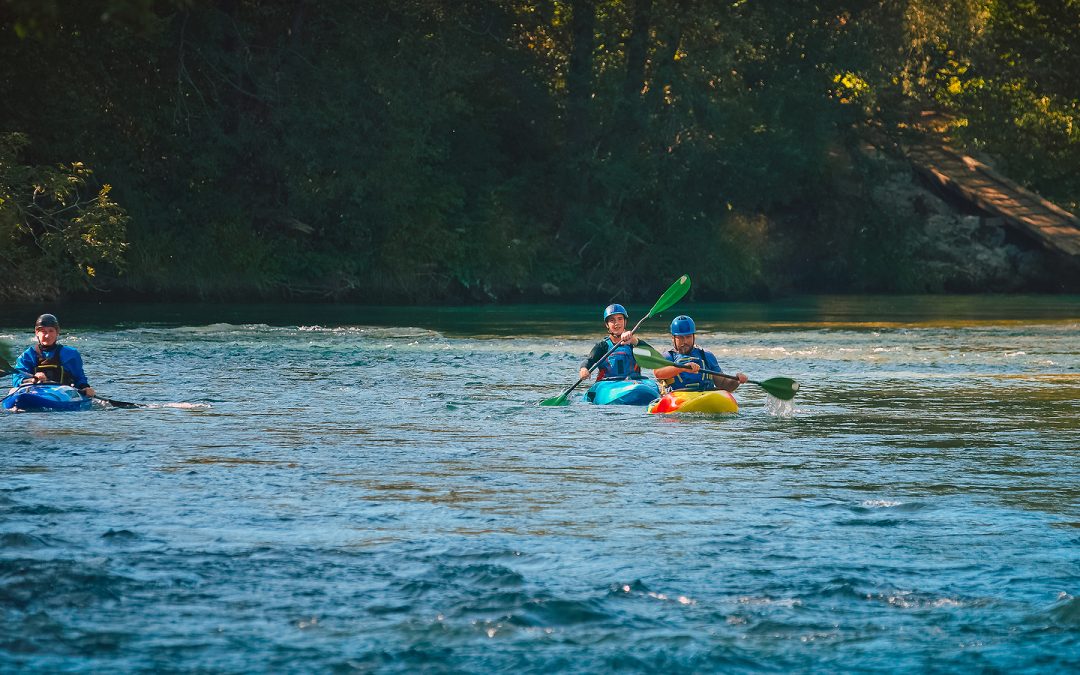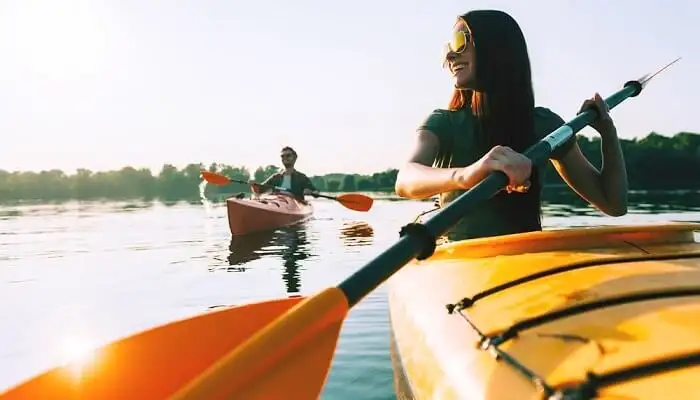Selecting the right fishing rod for kayak fishing is an important decision that directly affects the success and enjoyment of your time on the water. The unique challenges of fishing from a kayak demand that anglers choose rods with specific features tailored to this style of fishing. The ideal kayak fishing rod should not only fit within the confined space of a kayak but also be light enough to handle with ease over extended periods. This becomes more crucial when considering that kayak anglers often have less room to maneuver and store their gear compared to traditional boat fishing.
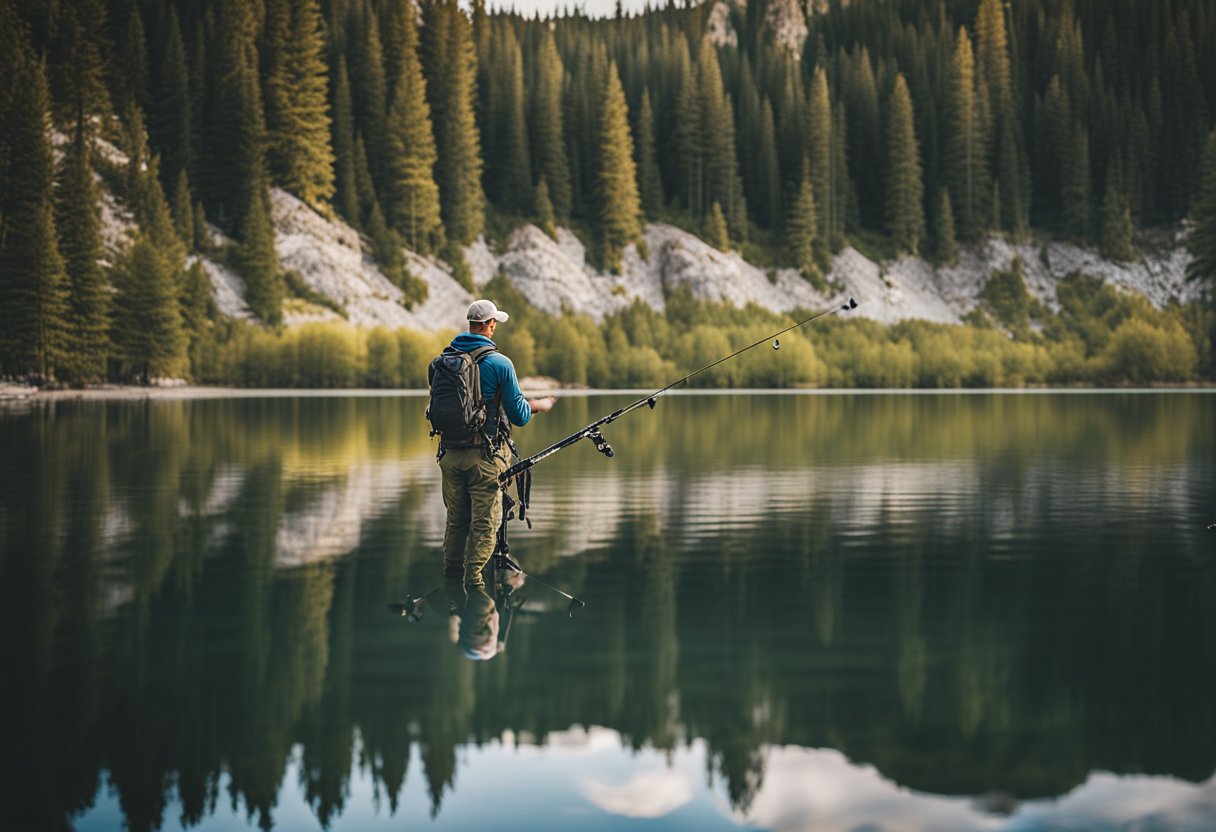
Understanding the key aspects of kayak fishing rods is vital for making an informed purchase. Factors such as rod length, power, action, and material composition play a significant role in how well a rod will perform in kayak fishing scenarios. Anglers must consider what species of fish they are targeting and the typical environments they fish in to select a rod that offers the right balance of sensitivity, strength, and versatility.
Key Takeaways
- A suitable kayak fishing rod must be compatible with the confined spaces and unique conditions of kayak fishing.
- Key characteristics such as length, power, and action are critical when choosing a fishing rod for kayak angling.
- The best kayak fishing rod choices balance sensitivity and strength for optimal performance in various fishing environments.
Understanding Kayak Fishing
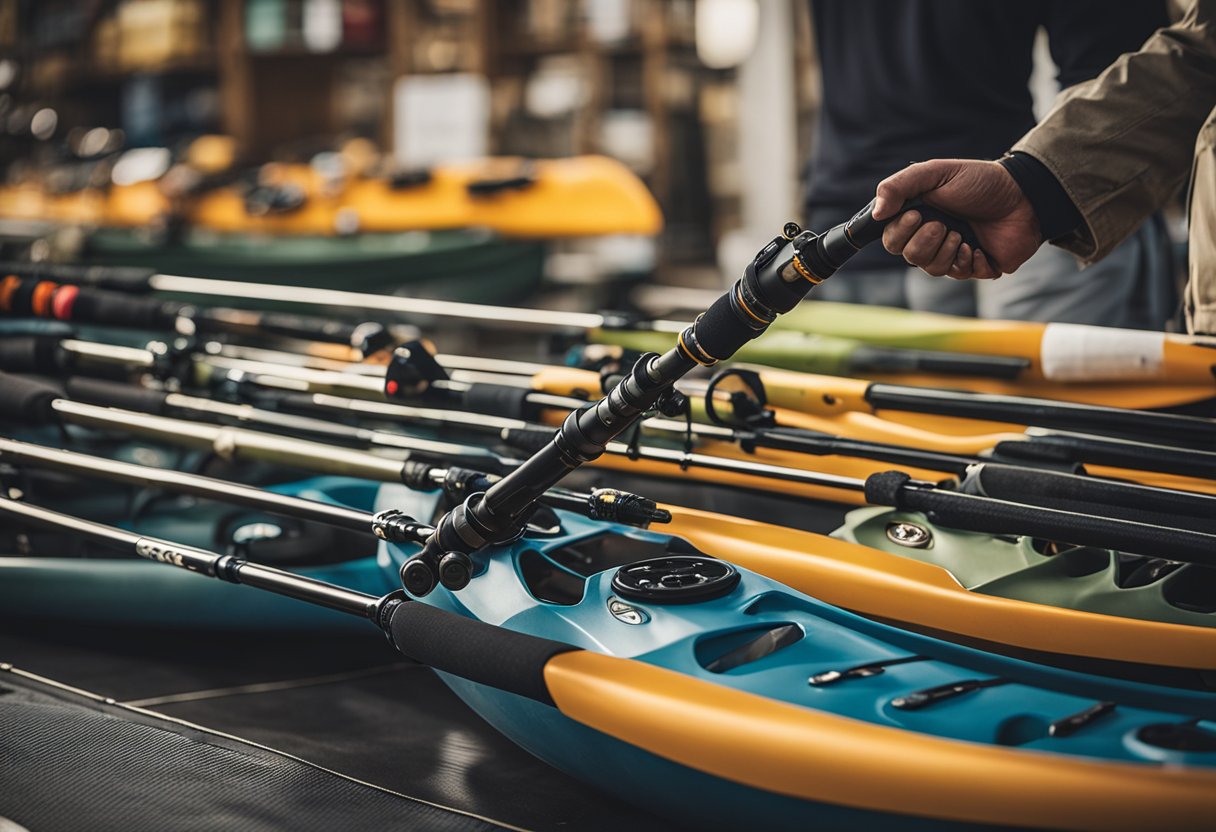
Kayak fishing is a method of angling that harnesses the simplicity and stealth of kayaks. As one chooses a kayak, stability is a pivotal consideration, particularly for anglers new to the practice. The stability of a kayak is gauged by its width and hull design—wider models with flat or pontoon hulls tend to offer greater stability, which is essential when casting lines and reeling in fish.
When selecting a kayak for fishing, prospective buyers should assess the following features:
- Width: A wider kayak provides better lateral stability, helping to prevent capsizing.
- Length: Shorter kayaks offer improved maneuverability, while longer ones track better in open water.
- Storage: Adequate storage for tackle, bait, and catch is crucial. Look for kayaks with built-in compartments and accessory mounts.
- Seat Comfort: Comfortable seating with good back support allows for extended periods on the water.
- Mounts and Accessories: Anglers should consider kayaks with options for rod holders, GPS devices, and other fishing gear.
When fishing from a kayak, anglers enjoy the benefits of reaching areas that are inaccessible to larger boats. They should, however, always remember to prioritize safety by wearing a personal flotation device and being mindful of water conditions.
It’s important to note that while stability is key, it should not compromise the kayak’s efficiency or maneuverability. Experienced anglers might prefer narrower kayaks for more speed and a more challenging experience.
Ultimately, determining the best kayak for fishing involves a balance between stability, maneuverability, storage, and personal comfort. Each angler’s choice will be influenced by their individual needs, preferred fishing locations, and skill level.
Fundamentals of Kayak Fishing Rods
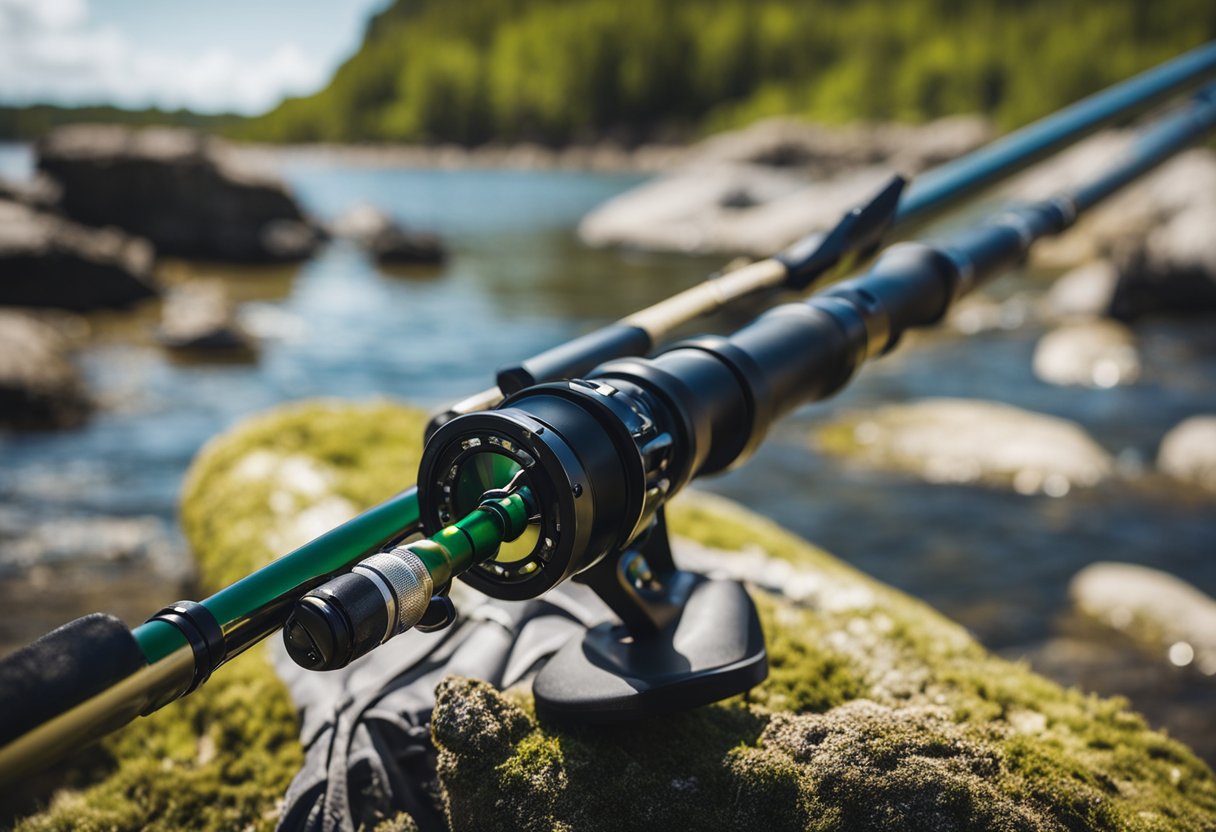
Selecting the best kayak fishing rod requires understanding its power, action, and length. These factors directly influence performance on the water and angler comfort.
Defining Rod Power and Action
Kayak fishing rods vary in power, which indicates how much force is needed to flex the rod. Rods are classified into categories such as low power, suitable for smaller fish, and high power, designed for battling larger species. Action, on the other hand, describes where the bend occurs. A slow action rod bends near the handle, while a medium or high action rod bends closer to the tip. The chosen combination affects casting accuracy and lure presentation.
| Rod Power | Ideal Usage |
|---|---|
| Low Power | Small fish, light baits |
| Medium Power | Versatile, all-around performance |
| High Power | Large fish, heavy lures |
| Rod Action | Bend Location | Casting Precision |
|---|---|---|
| Slow Action | Near handle | Lower |
| Medium Action | Midway | Moderate |
| Fast Action | Near the tip | High |
Considerations for Rod Length
When analyzing rod length for kayak fishing, shorter rods offer better maneuverability within the confined space of a kayak. They generally range from 6 to 8 feet, with the shorter end providing easier handling for quick direction changes. A longer rod may allow for longer casts, but the trade-off is reduced control and potential difficulty when reeling in fish close to the kayak. Additionally, short rear grips are beneficial because they facilitate easier movement within a kayak’s limited space.
- Short Rod (<7 feet): Better control, ideal for kayak confines.
- Long Rod (>7 feet): Longer casts, might be more cumbersome.
By carefully considering rod power, action, and length, anglers can enhance their kayak fishing experience with the right equipment tailored to their specific needs.
Key Features of High-Quality Rods
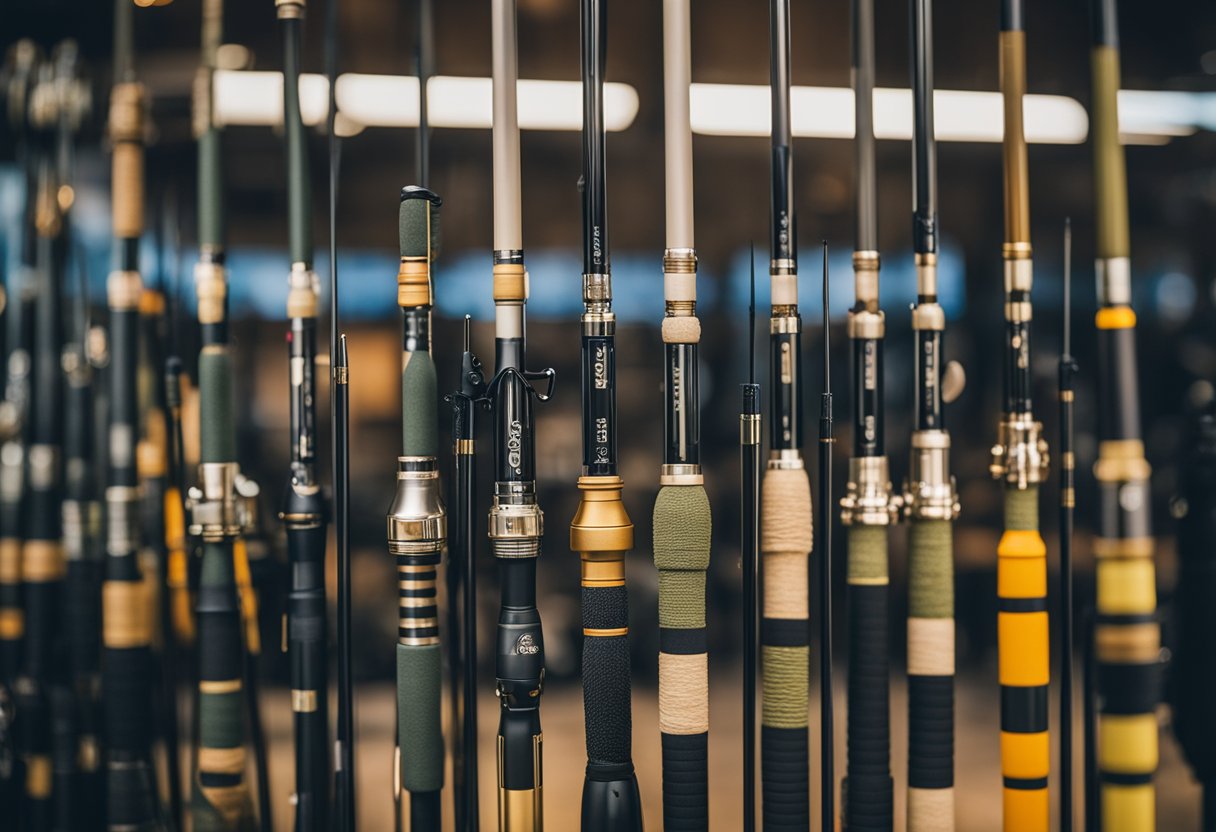
Choosing the right kayak fishing rod hinges on understanding the intricacies of rod design. High-quality rods embody optimal material choice and structural integrity, delivering the balance between sensitivity and strength necessary for successful angling.
Materials and Construction
Materials are the bedrock of any high-quality fishing rod. Graphite is a favored material for its lightweight properties and responsiveness, making it ideal for detecting subtle bites. Fiberglass blends durability with flexibility, offering a robust alternative for anglers targeting larger species. Advanced rods often utilize a composite construction, combining both materials to harness the advantages of each.
The rods’ construction determines their performance on the water. High-end rods typically feature Fuji components, renowned for their quality and durability. Fuji reel seats ensure a secure attachment of the reel, while alconite guides — which are lighter and can endure more stress than traditional guides — facilitate smoother line flow, reducing wear and enhancing castability.
Sensitive and Strong
Sensitivity in a rod is critical for detecting fish strikes, particularly in kayak fishing where the proximity to the water magnifies the angling experience. Graphite rods offer excellent sensitivity, allowing anglers to feel the lightest of nibbles. However, the best rods balance this with strength to ensure they can handle the fight with the fish once hooked.
A high-quality rod’s strength is signified by its ability to withstand stress without breaking. Strong rods utilize a higher modulus graphite or reinforced fiberglass to provide the needed backbone for battling larger fish. It’s about ensuring that the rod can transmit vibrations effectively while having the resilience to not snap under pressure. The materials and construction should culminate in a rod that is sensitive enough for bite detection yet robust enough to bring in the catch.
Selecting the Right Type of Rod
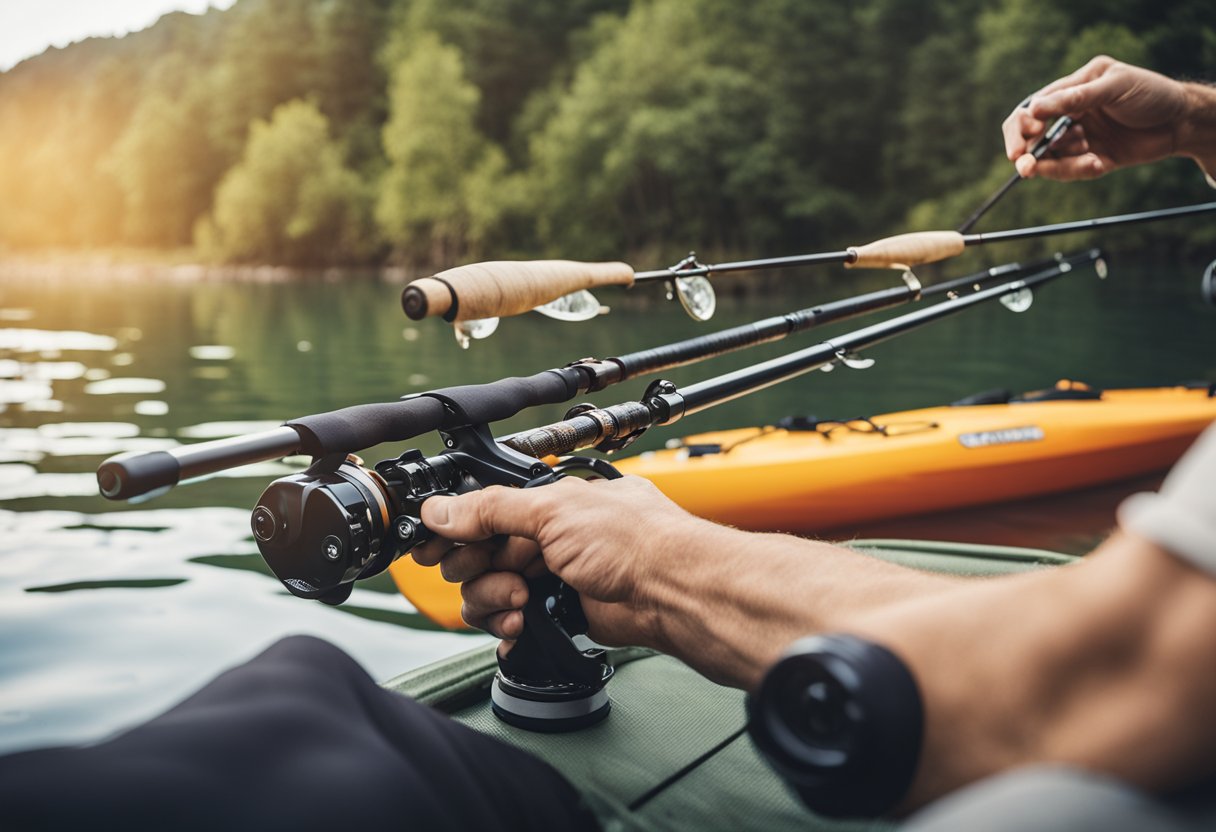
When choosing a kayak fishing rod, the type of rod is a critical factor that can influence your angling success and comfort. The main considerations include deciding between spinning and casting models and selecting the appropriate rod for either freshwater or saltwater environments.
Spinning Vs. Casting Models
Spinning Rods:
- Ideal for Beginners: They offer ease of use and a straightforward design which is conducive for those new to kayak fishing.
- Versatile: Effective for a variety of fishing techniques and can handle a wide range of bait and lure sizes.
Casting Rods:
- Precision: Provide greater casting accuracy which is beneficial for targeting specific areas.
- Casting Power: Baitcaster setups are generally known for their enhanced casting power and control, especially when using heavier lures.
Specifics for Saltwater and Freshwater
Freshwater Fishing:
- Rod Material: Often lighter and designed for catching a diverse range of freshwater species.
- Corrosion Resistance: Less of a concern than in saltwater rods, but still important for durability.
Saltwater Fishing:
- Material and Build: Constructed to withstand the corrosive nature of saltwater and the potential for larger, more powerful saltwater species.
- Inshore Fishing: When targeting inshore species, shorter rods with higher sensitivity and strength are often recommended.
The Importance of Weight and Compactness

Selecting a kayak fishing rod with the right weight and a compact design is crucial for an angler’s comfort and efficiency. A lightweight rod reduces fatigue, allowing one to fish for extended periods without discomfort. It’s essential for those who venture out on lengthy trips or engage in constant casting.
Weight is not just about ease of use, but also influences the rod’s sensitivity. A lighter rod often provides a better feel for what’s happening underwater, especially when targeting species that give a subtle bite. However, balance is key; too light may sacrifice the power needed for larger catch.
A compact rod benefits storage and transportation. Kayak spaces are limited, and a bulky rod can be cumbersome. Many rods designed for kayak fishing are breakdown or telescoping models, adding to their portability.
| Feature | Advantages |
|---|---|
| Lightweight | - Reduces fatigue - Increases sensitivity |
| Compact Design | - Convenient for travel |
Manufacturers today focus on creating rods that don’t compromise strength, despite their lightweight and compact nature. Durability is also a priority, ensuring that the rod withstands the challenges of kayak fishing environments.
Lastly, some rods offer modular or interchangeable sections that add to their versatility, allowing one to tailor the rod length and power to the specific fishing conditions they encounter. While compactness and weight are significant factors in the selection process, a fisherman should still consider these features in conjunction with the overall performance of the rod to find the best fit for their kayak fishing needs.
Innovations in Kayak Fishing Rods
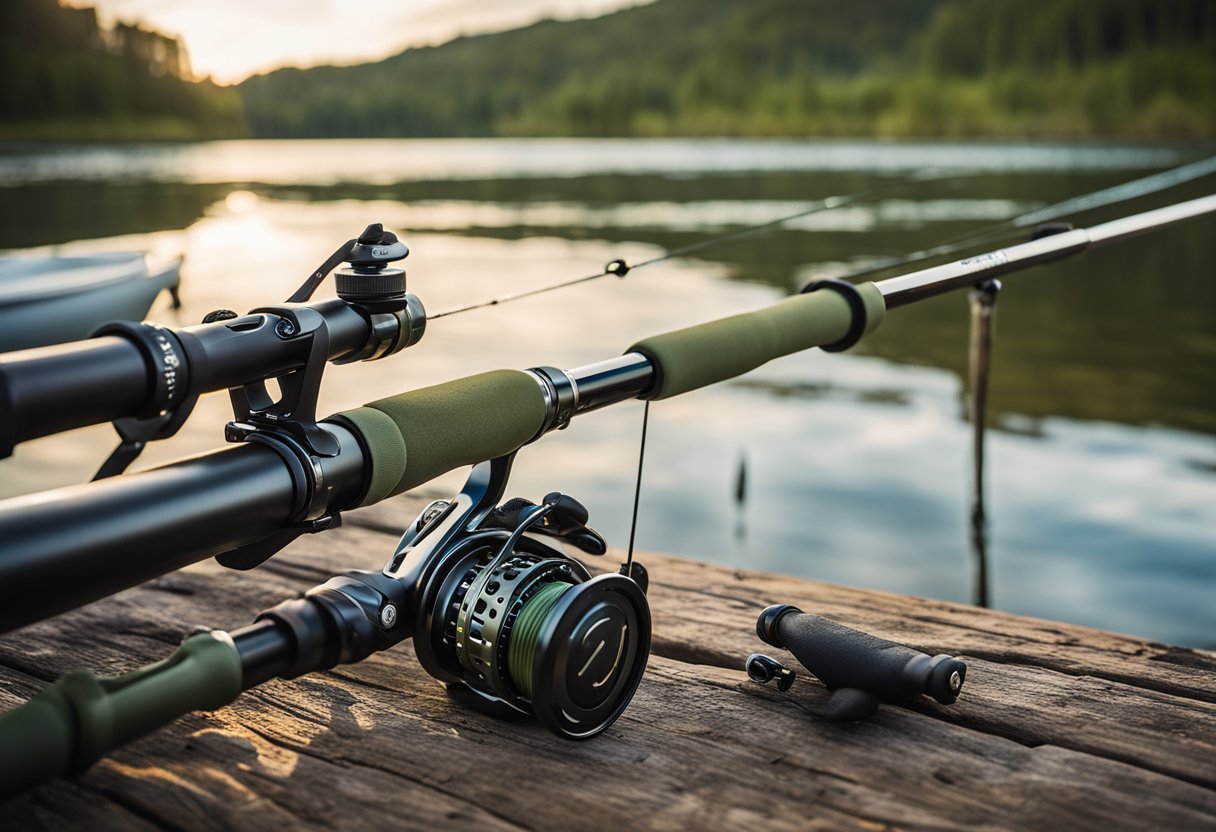
In the world of kayak fishing, technological advancements have led to the development of equipment designed for efficiency and convenience. These innovations not only enhance the fishing experience but also provide specialized tools for the unique challenges of fishing from a kayak.
Rod Holders and Accessories
Manufacturers have designed rod holders to optimize space and provide ease of access, which is critical in the confined quarters of a kayak. These are often made to be adjustable and can be positioned in various locations on the kayak for maximal flexibility. Options include:
- Flush-mounted holders: Integrated into the kayak’s body, they offer a sleek design.
- Deck-mounted holders: Allow for easy installation and multiple positioning options.
- Adjustable holders: These holders can swivel and tilt, providing anglers with the ability to change rod angles as needed.
Accessories, such as mounting systems and tool organizers, have also seen advancements, integrating materials like UV-resistant plastics and corrosion-resistant metals to withstand the harsh marine environment.
The Rise of Kayak-Specific Rods
The emergence of kayak-specific rods addresses the need for shorter lengths and more robust backbones to fight fish in tight spaces. These rods prioritize:
- Shorter lengths: Generally ranging from 6 to 8 feet, allowing for easier maneuverability around the kayak.
- Increased sensitivity: Helps detect subtle bites that are common when kayak fishing.
- Durability: Constructed to endure the stress of being used in a confined space and the potential of interacting with the kayak itself.
These rods may come with features such as split grips or shorter handles, which make it easier to fish while seated and provide better leverage when casting and retrieving.
Reel Compatibility and Recommendations

When selecting a kayak fishing rod, one must ensure that the rod’s reel seat is compatible with the intended fishing reel. A proper match affects performance and comfort during long fishing sessions.
Matching with Reels
The kayak angler should first verify that the reel seat on the fishing rod can securely accommodate their chosen reel—whether that be a spinning combo or a baitcasting reel. Spinning reels are often preferred by beginners due to their ease of use and versatility. They should fit snugly into the reel seat with no wiggle room. Baitcasting reels, favored by experienced anglers for precision and strength, require a rod with a reel seat designed for their unique build and function.
- Reel Seat Types to Consider:
- Spinning Rod Reel Seat: Wider and typically made to accommodate spinning reels.
- Casting Rod Reel Seat: Smaller, designed for the trigger grip common to baitcasting reels.
Preferred Reel Features
Anglers should look for reels with a smooth drag system, ensuring consistent pressure is applied to caught fish, as well as a high-quality ball bearing system for reel stability and smooth operation.
- Key Reel Features:
- Drag: A high-quality drag system allows for fine adjustments and can handle varying sizes of fish.
- Bearings: More bearings typically equate to smoother retrieval and casting. Look for reels with shielded or sealed bearings to prevent corrosion.
Recommendations for Reel Specifications:
Feature Spinning Reel Baitcasting Reel
Bearings At least 5 bearings 5-10 bearings preferred
Drag System Front-adjustable drag Star drag for easy thumb access
By matching the correct reel with the appropriate rod and prioritizing key features, an individual can greatly enhance their kayak fishing experience.
Optimizing Lure and Line Choices
When selecting fishing gear, the angler’s success hinges on the proper pairing of lures and lines to ensure optimal performance and accuracy. These choices directly influence the catch rate and the overall fishing experience.
Selecting Appropriate Lures
The type of lure is pivotal for kayak fishing, with jig and crankbaits being popular choices for their versatility and effectiveness. A jig, a weighted hook with a lead head opposite the sharp tip, can be adorned with a variety of baits. They excel in precision, allowing the angler to target fish near structures or at various depths. It’s crucial to match the jig size to the target species for the best results.
Crankbaits have a distinct profile and a broad swimming action, making them perfect for covering large areas and attracting aggressive predator fish. Their built-in action requires less input from the angler, making them an excellent choice for novices and experienced fishermen alike. They come in an array of sizes and styles to resemble different prey species.
Line Types and Braided Options
Line choice directly affects fishing performance. A braided line is often recommended for kayak anglers due to its superior strength and lack of stretch, which allows for greater sensitivity and a firmer hook set. While monofilament and fluorocarbon lines have their benefits, such as better knot strength and reduced visibility, respectively, braided lines excel in delivering precise lure movements and managing the fight with larger fish.
Braided lines are characterized by their:
- High strength-to-diameter ratio
- Excellent durability
- Minimal line memory
However, anglers should consider water clarity and cover when selecting line type, as braided lines can be more visible in clear water. To address this, one may employ a fluorocarbon leader, which combines the benefits of both line types: the sensitivity of braid and the invisibility of fluorocarbon.
Expert Picks for Kayak Fishing Rods
Selecting the best kayak fishing rod depends on targeting specific fish species and choosing a renowned brand for durability and performance.
Top Rods for Different Species
For small fish like panfish, the Ugly Stik GX2 offers exceptional sensitivity and durability. It’s a versatile choice that stands up to the rigors of kayak fishing.
When aiming for medium-sized fish such as catfish or bass, the St. Croix Mojo Yak Spinning Rod provides the perfect balance of strength and flexibility needed to handle vigorous fights.
Anglers pursuing snook or striped bass will find the Falcon Rods Coastal Spinning Rod reliable for casting accuracy and its ability to manage sudden runs.
For those targeting powerful species like tarpon and yellowtail, the Shimano Trevala stands out for its specialized jigging action and robust construction, capable of landing these formidable adversaries.
Industry-Leading Brands
- Shimano
- Renowned for the Shimano Trevala, favored for heavy-duty offshore kayak fishing.
- Falcon Rods
- The Falcon Rods Coastal Spinning Rod is praised for its species-specific designs.
- Ugly Stik
- The Ugly Stik GX2 is praised for its nearly indestructible rod, essential for kayak anglers who may subject their gear to rough handling.
- St. Croix
- St. Croix Mojo Yak Spinning Rod is designed with kayak anglers in mind, offering shorter handles for better maneuverability.
- Abu Garcia
- Known for quality gear, their rods offer a good blend of strength to handle larger fish like catfish, yet are responsive enough for kayak fishing environments.
Assessing Rod Specifications
When selecting a kayak fishing rod, one must consider the rod’s specifications to ensure an optimal match to their fishing needs. These specifications include the rod’s length, line test rating, and rear grip length. It is crucial to understand these variables to make an informed choice.
Rod Length:
The length of the rod influences casting distance and accuracy. Common lengths for kayak fishing rods range from 6 to 8 feet.
- Short Rods (6-7 feet): Offer better maneuverability and control for kayak anglers in tight spaces.
- Long Rods (7-8 feet): Provide greater casting distance and are beneficial in open water.
Line Test Rating:
This rating indicates the strength of the line that should be used with the rod and is a gauge of the rod’s power range.
- Lighter Rating: Suitable for smaller fish species and finesse techniques.
- Heavier Rating: Necessary for targeting larger fish and enduring tougher conditions.
Rear Grip Length:
The length of the rear grip affects the leverage and control the angler has over the rod.
- Shorter Grips: Allow for easier one-handed casting which is often advantageous in a kayak.
- Longer Grips: Provide more leverage for two-handed casts and can help battle larger fish.
Conclusion: Choose a rod that aligns with your target species, fishing conditions, and personal comfort. An informed approach to assessing rod specifications will enhance your kayak fishing experience.
Additional Considerations for an Ideal Setup
When establishing an ideal kayak fishing setup, several factors beyond the rod itself are crucial for success.
Fish Finder:
A fish finder can be a game-changer, providing insight into what lies beneath the water’s surface. Select a model suitable for the size and design of the fishing kayak. Look for compact and waterproof options with clear displays.
Kayak Fishing Gear Organizers:
Maximize space by using gear organizers designed for kayaks. They should secure tackle and tools efficiently while keeping them within easy reach.
Speed and Stability:
The speed of a fishing kayak impacts how quickly an angler can reach their preferred spot. However, stability should not be compromised. A stable kayak is essential, especially when reeling in large fish or casting from a seated position.
Fishing Kayak Dimensions:
A kayak’s length and width influence its navigation through various water bodies. For streams and narrow waterways, agile and slimmer kayaks are preferable. They maneuver more easily around obstacles and can be advantageous when pursuing fish in tight spaces.
| Factor | Consideration |
|---|---|
| Fish Finder | Compact, waterproof, clear display |
| Gear Organizers | Maximize space, easy access |
| Speed | Fast enough to reach fishing spots, balanced with stability |
| Stability | Enables safe casting and reeling |
| Dimensions | Suited to environment—slim for streams, wider for open waters |
To summarize, integrate a reliable fish finder, an efficient gear organization system, and consider the kayak’s speed and stability needs. Choose a kayak that fits the environment where it will be used, whether it’s the narrow confines of streams or the broader expanses of lakes and coastal waters.
Frequently Asked Questions
Selecting the right kayak fishing rod is crucial for a successful outing on the water. These FAQs focus on the key aspects to consider for the best fishing experience.
What should I consider when choosing a fishing rod for kayak fishing?
One must assess the fishing rod’s length, action, power, and material for compatibility with kayak constraints and targeted fish species. The rod should enable precise control and maneuverability within the limited space of a kayak.
What makes a spinning rod preferable to a casting rod for kayak fishing?
Spinning rods are often favored for kayak fishing due to their ease of use and versatility in handling lightweight lures and baits. They allow for longer casts with less likelihood of line tangling, which is particularly advantageous in the confined space of a kayak.
What is the ideal rod length for kayak fishing in saltwater environments?
For saltwater kayak fishing, a rod length of around 7 to 8 feet strikes a good balance between casting distance and manageability. Shorter rods offer greater control when fighting fish, whereas longer rods enable broader coverage of water.
How does rod and reel combo affect my fishing experience while on a kayak?
The combination of rod and reel determines the balance and overall handling of the setup. A well-matched combo ensures better casting accuracy, efficient retrieval, and reduced fatigue during prolonged use, enhancing the kayak fishing experience.
How do I select a fishing reel that’s suitable for kayak fishing?
Choose a durable reel that can withstand the corrosive saltwater environment, if applicable. Also consider the reel’s size, gear ratio, and drag system to match the targeted fish species and ensure comfortable usability from a kayak.
How many fishing rods are recommended for a kayak fishing trip?
It is advisable to carry two or three rods, each with different setups to quickly adapt to changing conditions and targeted fish without re-rigging. The limited space on a kayak requires careful selection to maximize efficiency.





